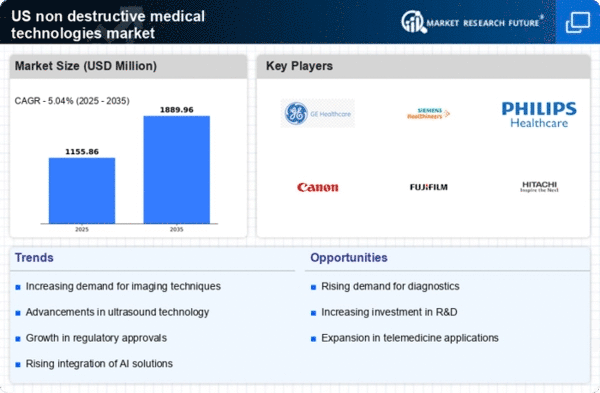The non destructive-medical-technologies market is characterized by a dynamic competitive landscape, driven by innovation, technological advancements, and strategic partnerships. Key players such as GE Healthcare (US), Siemens Healthineers (DE), and Philips Healthcare (NL) are at the forefront, each adopting distinct strategies to enhance their market positioning. GE Healthcare (US) emphasizes digital transformation and AI integration, aiming to streamline operations and improve diagnostic accuracy. Siemens Healthineers (DE) focuses on expanding its product portfolio through strategic acquisitions, while Philips Healthcare (NL) prioritizes sustainability and patient-centric solutions, reflecting a broader industry trend towards environmentally responsible practices.
The market structure appears moderately fragmented, with several players vying for market share. Companies are increasingly localizing manufacturing and optimizing supply chains to enhance efficiency and reduce costs. This collective approach not only strengthens their competitive edge but also fosters innovation, as firms collaborate on research and development initiatives. The influence of these key players is substantial, as they shape market trends and set benchmarks for quality and technological advancement.
In October 2025, Siemens Healthineers (DE) announced the acquisition of a leading AI diagnostics firm, a move that is likely to bolster its capabilities in predictive analytics and enhance its product offerings. This strategic acquisition underscores the importance of AI in the current market, as companies seek to leverage advanced technologies to improve patient outcomes and operational efficiency. The integration of AI into Siemens' existing systems may provide a competitive advantage, positioning the company as a leader in innovative healthcare solutions.
In September 2025, Philips Healthcare (NL) launched a new line of eco-friendly imaging systems, aligning with its commitment to sustainability. This initiative not only addresses growing environmental concerns but also caters to a market increasingly focused on sustainable practices. By prioritizing eco-friendly technologies, Philips is likely to attract environmentally conscious healthcare providers, thereby enhancing its market share and reinforcing its brand reputation.
In November 2025, GE Healthcare (US) unveiled a groundbreaking imaging technology that utilizes advanced machine learning algorithms to enhance image clarity and reduce radiation exposure. This innovation is expected to set new standards in diagnostic imaging, reflecting GE's commitment to pushing the boundaries of technology. The introduction of such advanced solutions may shift competitive dynamics, as other players will need to innovate rapidly to keep pace with GE's advancements.
As of November 2025, the competitive trends in the non destructive-medical-technologies market are increasingly defined by digitalization, sustainability, and AI integration. Strategic alliances are becoming more prevalent, as companies recognize the value of collaboration in driving innovation and enhancing product offerings. Looking ahead, competitive differentiation is likely to evolve, with a shift from price-based competition to a focus on innovation, technology, and supply chain reliability. This transition may redefine market dynamics, compelling companies to invest in cutting-edge technologies and sustainable practices to maintain their competitive edge.

















Leave a Comment